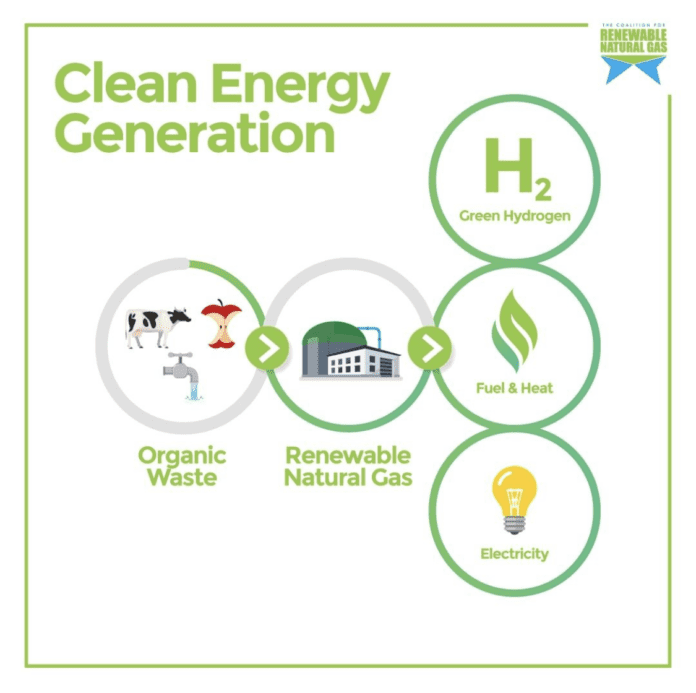This article was written by Sam Lehr.
Developing cost- and climate-effective hydrogen resources has been at the forefront of many recent conversations surrounding decarbonization of everything from existing thermal loads to transportation and power applications. Most of this conversation has revolved around hydrogen made from natural gas or clean electricity, including their respective color monikers, as societyebates which resources constitute a viable climate strategy.
Often overlooked is the potential to create renewable hydrogen (RH2) from biological resources such as biogas, renewable natural gas (RNG), and other waste biomass resources. In fact, these production pathways hold the greatest potential for both reducing carbon emissions and facilitating cross-sectoral environmental benefits on a per-energy-unit basis.
Biogas production is inevitable in every society. It is created when organic waste decomposes naturally, under anaerobic conditions; the largest and most common sources are landfills, wastewater treatment facilities, animal manure from livestock and agricultural operations, and dedicated anaerobic digestion (AD) systems that manage aggregated food waste and other organic materials that have been diverted from landfills. Because raw biogas cannot be dispensed into a vehicle or injected into and transported via the gas pipeline system, it is treated and conditioned (or upgraded) to RNG, so that it can directly substitute for conventional natural gas in vehicles and or decarbonize our existing gas infrastructure. Hydrogen production technologies that would otherwise use conventional natural gas as a feedstock can instead use RNG, with any resulting carbon dioxide (CO2) emissions having a neutral effect on atmospheric carbon load. Comparatively, processes such as gasification can be used to produce hydrogen from fibrous materials such as waste wood and crop waste. RH2 produced from these feedstocks can collectively be described as biologically derived hydrogen or biohydrogen.
Perhaps the most important aspect of biohydrogen is its ability to achieve the lowest carbon intensity (CI) of any hydrogen production pathway — including that which is derived from clean electricity. When the biogenic carbon contained in these feedstocks (as opposed to that which is extracted from fossil resources) is sequestered using carbon capture technologies such as biochar or geologic storage, biohydrogen can be carbon-negative, effectively serving as a method of extracting CO2 from the atmosphere. Lawrence Livermore National Laboratory exemplifies this process in a recent study which outlines the potential for California to reach economywide carbon-negativity by employing bioenergy resources such as RNG and biohydrogen in tandem with carbon capture and storage (CCS).
Similarly, greenhouse gas benefits are achieved where RNG-derived biohydrogen production pathways result in the capture and destruction of methane emissions that would otherwise escape into the atmosphere when and where no biogas collection and upgrading system is in place. Under the California Air Resources Board’s (CARB) Low Carbon Fuel Standard (LCFS) program, hydrogen produced from RNG feedstocks have achieved a CI score of as low as -390.47 g CO2e/MJ. From a climate standpoint this is the most beneficial hydrogen production pathway under the LCFS program.
In addition to the unique carbon reduction pathways achievable through CCS and methane abatement or mitigation, hydrogen derived from organic waste can facilitate broader, non-climate environmental benefits. Developing practical uses for biogas and waste materials from forestry or other industrial processes provides an incentive to better manage organic waste streams. This contributes to the circularization of our economy and can benefit communities and ecosystems affected by poor waste-handling practices. For example, using forest debris to produce RNG or hydrogen is being explored as one way to lessen the effects of wildfires in California. The production of biochar, either directly from an RNG or biohydrogen feedstock or from AD byproducts such as digestate, can be used as a soil amendment and, when buried or used to make long-lived materials, is a form of carbon sequestration.
Recycling organic waste in a circular fashion to create carbon-negative renewable energy epitomizes sustainability. As we focus on circularity and the impact we are having on our environment, resources with multisectoral environmental benefits such as RNG and biohydrogen deserve increased attention and a proper place alongside their more commonly discussed intermittent renewable energy counterparts, as they are uniquely valuable technologies that represent harmonious and complementary, no-regrets solutions in our quest to truly decarbonize our economy.
About The Author
Sam Lehr serves as the RNG Coalition’s Manager of Sustainability and Markets Policy. He previously worked on renewable fuels policy and compliance at Montauk Energy, a founding member of RNG Coalition and an RNG producer in the United States. His experience also includes time with solar energy and green tech start-ups in Pittsburgh. Lehr holds a BS in Environmental Science and MS in Environmental Science and Management from Duquesne University.

















